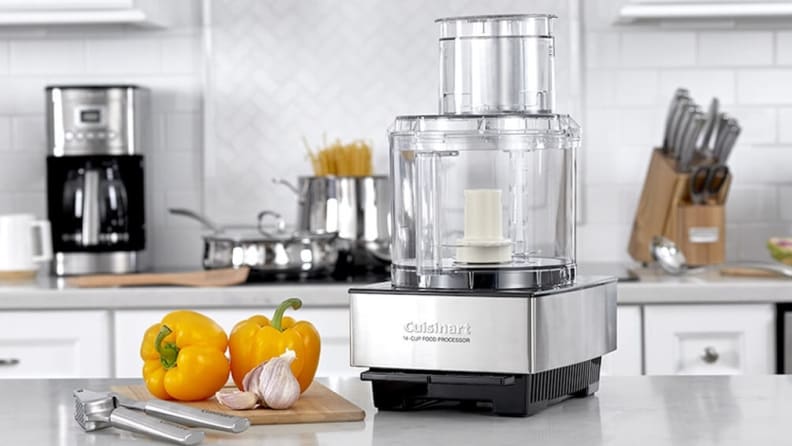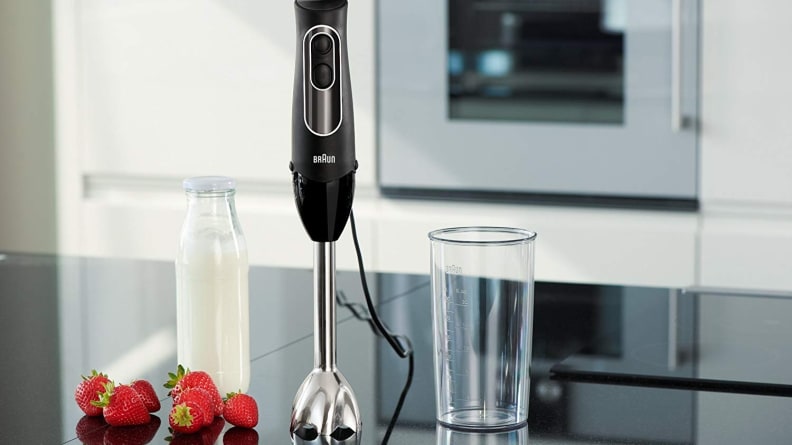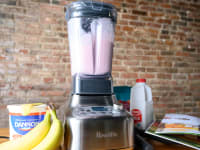Food processors vs blenders: What's the difference?
They both have spinning blades, but the similarities end there.
 Credit:
Cuisinart
Credit:
Cuisinart
Recommendations are independently chosen by Reviewed's editors. Purchases made through the links below may earn us and our publishing partners a commission. Prices were accurate at the time this article was published but may change over time.
If you’re anything like us, you probably have a number of small appliances in your kitchen. Among your collection, you likely have a food processor or blender—or maybe even both! But do you know the key differences between these two appliances?
Most people know to use a blender for smoothies and a food processor for chopping vegetables, but what makes one tool better suited for these tasks than the other? Strap in, because we're going to dive into what makes these kitchen appliances tick—or should we say, spin.
What to know about food processors

Food processors are ideal for chopping food.
Food processors should be your go-to tool when doing meal prep. This appliance chops, slices, pulses, and purees ingredients, whether you’re prepping them one at a time or all at once.
You can also think of it this way: You should use your food processor when you cut whole ingredients into smaller pieces. This includes chopping onions, slicing carrots, and even cutting butter into pastry dough. A food processor is also a great choice for dishes that call for several chopped ingredients blended together—such as pesto and salsa.
How it compares
- The blades: Unlike blenders, food processors come with very sharp spinning blades—the standard blade is s-shaped with dual prongs, which provides quick and effective chopping and mixing. The blade is typically removable, and different food processor attachments like slicing blades and shredding discs allow you to do more complex food prep.
- The motor: Food processors come with a standard motor—the real power comes from the blades.
- The bowl: Food processors come in a variety of sizes, with bowls ranging from 3 cups to 15 cups or more. They typically have feed tubes, as well, which can be used to safely add ingredients while the machine is on.
- Cleaning: It can be cumbersome to clean a food processor since there are so many pieces. The main thing to keep in mind is safety—those blades are sharp! We recommend reading the owner’s manual for your food processor to see which parts, if any, are dishwasher safe.
These are the basics, but for a more in-depth discussion of this appliance, we have additional tips on how to use a food processor.
What is a food processor used for?
Bottom line? Use a food processor for:
- Pesto
- Pasta sauce
- Pastry and cookie dough
- Slicing and grating cheese
- Chopping, slicing, and dicing vegetables
- Chopping, slicing, and grating dry ingredients
What is the best food processor?
Our favorite food processor—the Cuisinart “Custom 14” (available at Amazon)—excelled in almost all our tests, is easy to use, and has dishwasher safe parts. In addition to the s-shaped blade for chopping, mixing, and bread dough, this 14-cup food processor comes with shredding and slicing discs.
Get the Cuisinart Custom 14 from Amazon
What to know about blenders

Blenders put the smooth in smoothies—and other liquidy concoctions.
There are so many types of blenders available, but at their core, all of them are born to puree. If you want a smooth, velvety texture, you should break out the blender.
How it compares
- The blades: Unlike food processors, blender blades are quite dull. You still don’t want to stick your hand in there, but the true power of your blender comes from the motor, not the blades.
- The motor: Blenders have a stronger motor than food processors, allowing the blades to spin quickly, easily pureeing your ingredients. Speed and power combine to make your blender an effective tool.
- The bowl: Most blender bowls are made for pouring, so they feature a lip and measurements on the side. The lid may also feature a small removable plug, which allows you to add ingredients during the blending process.
- Cleaning: It's easier to clean a blender. The base doesn’t get too messy (unless something has gone terribly wrong), so you really just need to clean the blades and bowl. Both are detachable and can be washed separately, which allows you to take care when washing the blade. Alternatively, some people just put warm, soapy water in their blender, then turn it on, allowing the appliance's power to do the cleaning.
What is a blender used for?
When in doubt, use your blender for:
- Smoothies
- Soups
- Frozen drinks
- Milkshakes
- Pureed fruits
- Crushed ice
What is the best blender?
Our favorite full-size blender—the Cuisinart Hurricane (Available at Amazon)—makes smooth smoothies quickly, evenly crushes ice, and has intuitive controls. Plus, the blender jar and lid are dishwasher-safe.
Get the Cuisinart Hurricane from Amazon
For something smaller, try our favorite personal blender—the NutriBullet Select (Available at Amazon). This 1000-watt blender is fast and efficient, blends smoothly, and is versatile.
Get the NutriBullet Select from Amazon
What to know about immersion blenders

Immersion blenders are great when you're strapped for space.
But wait—what about the blender's little cousin, the immersion blender? This stick-like specialty blender is unique enough to warrant its own discussion.
These handheld kitchen appliances are inexpensive, lightweight and compact. They’re easy to clean and store, making them the ideal choice for novice chefs or cooks who don’t have much kitchen space. This appliance is great for small-batch cooking, soup making, and churning. Many people love using them to puree soup ingredients in the pot itself, which saves you from having to wash extra dishes!
How it compares
- The blades: The blades in an immersion blender are smaller and encased in a metal lip. When using an immersion blender, it’s important to remember the blades must be fully submerged before they can properly blend ingredients.
- The motor: While still powerful, the motor of an immersion blender is smaller and not as powerful as full-size models. You probably don’t want to crush ice with your immersion blender, but for pureeing, it will do just fine.
- The bowl: Depending on what you’re blending, you may not need to use the bowl that comes with your immersion blender. Some models include a small measuring bowl—perfect for small-batch pesto or smoothies—but if you’re blending something larger, you can use whatever bowl or pot you’ve prepared the ingredients in.
- Cleaning: The blending apparatus easily detaches from the motor, so rinsing and cleaning your immersion blender is quite easy.
Do you need both a standard blender and an immersion blender? Maybe. Most anything you'd make with an immersion blender can be made in a normal blender—but the reverse doesn't hold true. The uses of immersion blenders are more limited, making them a good, affordable starting point if you're outfitting your kitchen for the first time.
What is an immersion blender used for?
Use an immersion blender for:
- Soups
- Creamy vinaigrette
- Small-batch smoothies
- Homemade butter
What is the best immersion blender?
Our favorite immersion blender is the GE G8H1AASSPSS (available at Amazon). It has a powerful motor, is lightweight, and is easy to clean, but it’s not dishwasher safe. Still, it passed all of our tests with flying colors.





